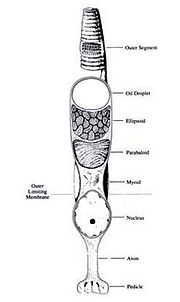User:Mccsco23
From Comparative Physiology of Vision
Contents |
Retina
The retina is composed of two segements, the outer segement and the inner segement. The outer segment contains disks with photosensitive pigment molecules. The orientation and size of these disks determines whether the photoreceptor cell is a rod or a cone. The outer segment connects to the inner segment by a ciliary stalk. The inner segment may have any or all of the following: an oil droplet, an ellipsoid, a paraboloid, and a myoid. A nucleus lies beneath the region of the myoid and is connected to a synaptic pedicle via an axon. The synaptic pedicle communicates with other retinal cells.
The difference and sensitivity of each cells is dependent upon the differences in the outer and inner segments. Disk orientation of the outer segments determines whether a cell is a cone or rod whereas the amount of oil, oil fluorescence, and cell size and shape all have a unique impact on cell behavior. Similar to other non-mammalian vertebrates, some visual cells may be fused. Two identical photoreceptors that are fused, or paired, in which the two members are completely identical. Double photoreceptors have two dissimilar cells where one acts dominant and the other as an accessory. These cells are bound together and appear to be electrically coupled.
Outer Segment
Like other vertebrates, the outer segment is composed of stacked disks within a plasma membrane. If the disks are discontinuous with the plasma membrane, they are a rod. However, if the disks are bulging against the membrane, they classified as a cone. Rods are responsible for vision at low illumination levels while cones are used for color vision at higher light levels.
The majority of photoreceptors in diurnal reptiles are cones. There some regions of the retina that exclusively contain cones. However, nocturnal reptiles experience a much greater quantity of rods than diurnal species. Comparatively, nocturnal reptiles have a similiar rod to cone ratios to that of humans.
Outer segments vary across species in size (length and diameter) and shape. The type of outer segment is dependent on behavior and habitat. The retinas of diurnal species have photoreceptors with narrow, short outer segments whereas nocturnal species increase light absorption by having long, thick, cylindrical outer segments. Nocturnal species that depend on vision for foraging have especially large outer segments.
Inner Segment
The inner segment organization is highly variable in reptiles. The ellipsoid and myoid are present in all species of reptiles and the paraboloid and an oil droplet may or may not be present in a photoreceptor.
Oil Droplet
Oil droplets are located at the tip of the inner segment. Its primary function is to concentrate incoming light and focus it onto the outer segment. The oil droplet is present in all species of reptiles excluding snakes and some nocturnal lizards. Oil droplets are a feature of cone cells in reptiles (rod cells do not contain oil droplets).
Oil droplets contribute to light collection because of their high refractive indices. Incoming light is concentrated onto the base of the outer membrane, almost directly above the oil droplet. The focusing of light onto the membrane causes a change in membrane potential. Increased light sensitivity due to oil droplets can improve retinal sensitivity and increase contrast differentiation and motion detection.
Most oil droplets are yellow, orange or red and are a derivative of carotenoid pigments and their concentrations. The droplets act as a filter, only redirecting light of a certain wavelength range onto the base of the outer segment. For example, red sensitive cones with a peak sensitivity of 620 nanometers would have a red oil droplet that only focuses light onto the outer segment that has a wavelength greater than 550 nanometers. The relationship causes specific photopigments to always be paired with their optimal oil droplet.
Ellipsoids
Ellipsoids are found in every reptile photoreceptor cell. It is composed of mitochondria and refracts light, contributing to light-redirecting properties of the inner segment. In the case of snakes whom lack oil droplets, the ellipsoid has lipid packets in its membrane that redirect incoming light onto the base outer segment. The ellipsoid is responsible for providing energy rich phosphates to the outer segment. [1]
The ellipsoids of reptiles consists of densely packed mitochondria. The arrangement of the mitochondria differs between species, however. Alligators are have long mitochondria that are arranged parallel to the photoreceptor, similar to mammals. Diurnal lizards have a central mitochondrion that is larger than the surrounding mitochondria. The size and internal structure of the ellipsoid varies greatly between species.

